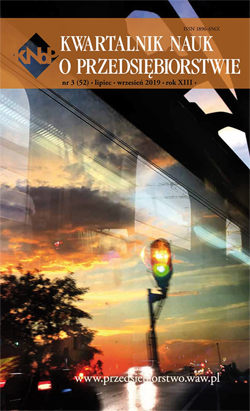Synergy in a family business, i.e. why 2 + 2 = 4 and not 5
Main Article Content
Abstract
The concept of synergy is described in many different branches of science. It does not necessarily mean increasing effects as a result of joint actions. It involves process of self-organization in terms of limited resources. Its occurrence is determined by the boundaries of chaos, and innovative actions allow to overcome barriers. Small businesses fall under the general laws of physics and thermodynamics. The author in the experiment puts the hypothesis, that one of the limited resources protected by entrepreneurs is the lifesource energy.
Downloads
Article Details
The author of the article declares that the submitted article does not infringe the copyrights of third parties. The author agrees to subject the article to the review procedure and to make editorial changes. The author transfers, free of charge, to SGH Publishing House the author's economic rights to the work in the fields of exploitation listed in the Article 50 of the Act of 4 February 1994 on Copyright and Related Rights – provided that the work has been accepted for publication and published.
SGH Publishing House holds economic copyrights to all content of the journal. Placing the text of the article in a repository, on the author's home page or on any other page is allowed as long as it does not involve obtaining economic benefits, and the text will be provided with source information (including the title, year, number and internet address of the journal).
References
Bałł G., Wilsz J. (2015), Koncepcja stałych indywidualnych cech osobowości w kontekście racjonalistyczno-humanistycznej metodologii nauk o człowieku, “Psychological Journal”, Vol. 21(2), p. 151-162.
Barczak P. (2018), Mała firma niszowa-próba zdefiniowania, „Kwartalnik Nauk o Przedsiębiorstwie”, nr 2, kwiecień-czerwiec, Oficyna Wydawnicza SGH w Warszawie, Warszawa, s. 24.
Bertalanffy L. (1950), The Theory of Open Systems in Physics and Biology, “Science”, Vol. 111, Issue 2872.
Corning P. (1998), The Synergism Hypothesis: On The Concept Of Synergy And It’s Role In The Evolution Of Complex System, “Journal of Social and Evolutionary Systems”, Vol. 21(2).
Fuller R.B., Applewhite E.J. (1975), Synergetics: Explorations in the Geometry of Thinking, Macmillan Publishing, p. 59.
Gasiul H. (2007), Teorie emocji i motywacji, Warszawa, Wydawnictwo Uniwersytetu K.S. Wyszyńskiego, s. 290.
Griffin R.W. (2006), Podstawy zarządzania organizacjami, Warszawa, PWN, s. 56.
Haken H. (1983), Advanced Synergetics. Istability Hierarchies of Self Organizing Systems and Devices, Springer-Verlag, p. 2-8.
Haken H. (1996), Principles of Brain Functioning, A Synergetic Approach to Brain Activity, Behavior and Cognition, Springer-Verlag.
Jędrusiak M. (2017), Eksperymentalne i modelowe badanie dynamicznych niestabilności w reakcjach chemicznych z udziałem nadtlenku wodoru, praca doktorska, UW, Warszawa.
Krawczyk S. (2011), Logistyka. Teoria i praktyka. Tom 1, Warszawa, Difin, s. 35.
Latash M.L. (2008), Synergy, Oxford University Press, p. 13-15.
Leland H.E. (2007), Financial Synergies and the Optimal Scope of the Firm: Implications for Mergers, Spinoffs, and Structured Finance, “The Journal of Finance”, Vol. LXII, No. 2.
Leszczewska K., Sobiecki R. (2011), Przedsiębiorstwa rodzinne wobec sytuacji kryzysowych, Studia i Analizy Instytutu Przedsiębiorstwa, Determinanty rozwoju przedsiębiorczości w Polsce, s. 293-314.
Mesjasz C., Szarucki M. (2017), Synergia i przewidywanie w strategii fuzji i przejęć, Studia Oeconomica Posnaniensia, Vol. 5, No. 9.
Ringelmann M. (1913), Recherches sur les moteurs animés: Travail de l’ homme, Institut National Agronomique, Paris.
Skowrońska A., Tarnawa A. (2018), Raport o stanie sektora małych i średnich przedsiębiorstw w Polsce, PARP, grupa PFR, Warszawa.
Turvey M.T., Carello C. (1996), Dynamics of Berstein’s Level of Synergies, Latash M.L., Turvey M.T. (ed.), New Jersey, Lawrence Erlbaum Associates, p. 9-12, 339-376.
Vijay M., Wind Y. (1988), Business synergy Does Not Always Pay Off, “Long Range Planning”, Vol. 21, No. 1, p. 59-65.
Williams K, Harkins S., Latane B. (1981), Identifiability as a Deterrent to Social Loafing: Two Cheering Experiments, “Journal of Personality and Social Psychology”, Vol. 40, No. 2, p. 303-311.
Zieleniewski J. (1982), Organizacja zespołów ludzkich. Wstęp do teorii organizacji i kierowania, PWN, Warszawa, s. 313.

